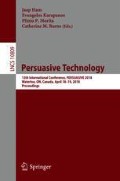Abstract
Shock tactics in the form of controversial messages are used in advertising to solicit viewer attention and as a persuasive tactic. Persuasive games are becoming increasingly popular, however the use of shock tactics in games have not been explored in much detail. This paper discusses how three Molleindustria games use potentially controversial mechanics and messages for persuasion. In a user study, we explored how the perceived controversy of these games influenced their efficacy. Overall, the results show that perceived controversy correlates significantly with the percentage of their study compensation participants were willing to donate. The findings point towards shock tactics as a potential tool for the design and evaluation of persuasive games.
Access this chapter
Tax calculation will be finalised at checkout
Purchases are for personal use only
References
Skorupa, P.: Shocking contents in social and commercial advertising. Creat. Stud. 7(2), 69–81 (2014)
Banyte, J., Paskeviciute, K., Rutelione, A.: Features of shocking advertising impact on consumers in commercial and social context. Innov. Mark. 10(2), 35–46 (2014)
Steinemann, S.T., Mekler, E.D., Opwis, K.: Increasing donating behavior through a game for change: the role of interactivity and appreciation. In: Proceedings of the 2015 Annual Symposium on Computer-Human Interaction in Play, pp. 319–329. ACM (2015)
Virvilaite, R., Matuleviciene, M.: The impact of shocking advertising to consumer buying behavior. Econ. Manage. 18(1), 134–141 (2013)
Urwin, B., Venter, M.: Shock advertising: not so shocking anymore. An investigation among generation Y. Mediterr. J. Soc. Sci. 5(21), 203 (2014)
Pflaumbaum, C.G.: Shock advertising-a sensationalised media construct? Ph.D. thesis, Curtin University (2013)
Cockrill, A., Parsonage, I.: Shocking people into action: does it still work? J. Advert. Res. 56(4), 401–413 (2016)
Dahl, D.W., Frankenberger, K.D., Manchanda, R.V.: Does it pay to shock? reactions to shocking and nonshocking advertising content among university students. J. Advert. Res. 43(3), 268–280 (2003)
Molleindustria: Unmanned. Game, Molleindustria, Pittsburgh (2012). http://www.phonestory.org/game.html
Molleindustria: McDonald’s Video Game. Game Molleindustria, Pittsburgh (2006). http://www.mcvideogame.com/
Molleindustria: Press listing (2016). http://www.molleindustria.org/blog/press/. Accessed 20 Sept 2016
Bogost, I.: Persuasive Games: The Expressive Power of Videogames. MIT Press, Cambridge (2007)
Molleindustria: Phone Story. Game, Molleindustria, Pittsburgh (2012)
Bilton, R.: Apple ’failing to protect Chinese factory workers’. BBC News, December 2014. http://www.bbc.com/news/business-30532463. Accessed 20 Sept 2016
Ferri, G.: Rhetorics, simulations and games: the ludic and satirical discourse of molleindustria. Int. J. Gaming Comput. Mediat. Simul. (IJGCMS) 5(1), 32–49 (2013)
Paperny, D.M., Starn, J.R.: Adolescent pregnancy prevention by health education computer games: computer-assisted instruction of knowledge and attitudes. Pediatrics 83(5), 742–752 (1989)
Oinas-Kukkonen, H., Harjumaa, M.: A systematic framework for designing and evaluating persuasive systems. In: Oinas-Kukkonen, H., Hasle, P., Harjumaa, M., Segerståhl, K., Øhrstrøm, P. (eds.) PERSUASIVE 2008. LNCS, vol. 5033, pp. 164–176. Springer, Heidelberg (2008). https://doi.org/10.1007/978-3-540-68504-3_15
Author information
Authors and Affiliations
Corresponding author
Editor information
Editors and Affiliations
Rights and permissions
Copyright information
© 2018 Springer International Publishing AG, part of Springer Nature
About this paper
Cite this paper
Rogers, K., Weber, M. (2018). Shock Tactics: Perceived Controversy in Molleindustria Persuasive Games. In: Ham, J., Karapanos, E., Morita, P., Burns, C. (eds) Persuasive Technology. PERSUASIVE 2018. Lecture Notes in Computer Science(), vol 10809. Springer, Cham. https://doi.org/10.1007/978-3-319-78978-1_16
Download citation
DOI: https://doi.org/10.1007/978-3-319-78978-1_16
Published:
Publisher Name: Springer, Cham
Print ISBN: 978-3-319-78977-4
Online ISBN: 978-3-319-78978-1
eBook Packages: Computer ScienceComputer Science (R0)

